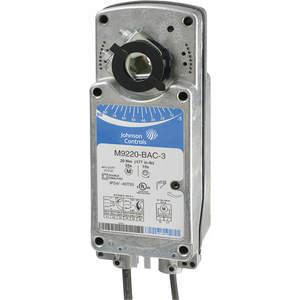Johnson Controls M9220-GGA-3 actuator is employed in HVAC systems for precise valve control. It is used to modulate the opening and closing of valves in heating, ventilation and air conditioning applications. This actuator ensures efficient temperature and flow control, maintaining optimal comfort and energy efficiency. It offers stable environmental conditions and minimises energy consumption.
Features:
- It features a reversible mounting design for easy installation and facilitating the spring return in either direction.
- This M9220-GGA-3 electric actuator has an electronic stall detection facility for increased service life by deactivating the motor during an overload condition.
- It comes with an aluminium enclosure for increased protection of the internal components and corrosion resistance.
- This electric actuator offers integral auxiliary switches to facilitate an adjustable and a fixed switch point.
Compatible Accessories:
- Johnson Controls M9000-519 Valve Linkage Kit: This ball valve linkage kit is used in HVAC systems with the brand's actuator to control the opening and closing of ball valves, regulating fluid flow for temperature and pressure control.
Frequently Asked Questions:
Q. What is the torque and power rating of this Johnson Controls M9220-GGA-3 actuator?
A. This actuator has a torque rating of 177 lb-inch and power rating of 20VA for improved electrical conductivity.
Q. Can this actuator be used for continuous operation?
A. Yes, this actuator features a manual override capability, allowing manual control during power loss or control system failure, ensuring continued functionality.
Q. Does this M9220-GGA-3 actuator have built-in feedback for position indication?
A.
- Refer to the actuator's documentation or specifications.
- Verify if it mentions built-in position feedback.
- Review the user manual for information on feedback features.
- If unsure, contact Johnson Controls support for clarification.
Q. Are there any recommended maintenance procedures for this Johnson Controls M9220-GGA-3 actuator?
A.
- Check for physical damage, loose connections and proper mounting.
- Apply recommended lubricant to moving parts as specified in the manual.
- Periodically calibrate position feedback for accurate readings.
- Keep the actuator clean from dirt and debris to prevent interference.
- Apply updates if provided by the manufacturer for optimal performance.
- Look for unusual sounds or erratic movement during operation.




